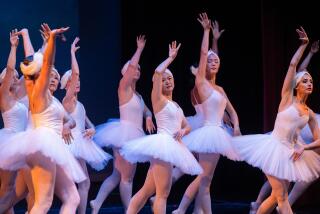‘WALPURGIS NACHT,’ ‘GLUCK MELODY’ BY MOSCOW BALLET
- Share via
With its repertory of derivative home-grown showpieces, revivals of staples from the previous generation and budget versions of the classics, the Moscow Ballet resembles the kind of hustling regional ensembles that proliferate in this country.
Where the Soviet company differs from its counterparts here is chiefly in its limited access to world-class choreographers and its consequent willingness to recycle the most ghastly native kitsch as if it were the artifact of a great creative tradition.
Consider Leonid Lavrovsky’s “Walpurgis Nacht,” the chief novelty on the Moscow Ballet program, Tuesday in the Dorothy Chandler Pavilion. First presented by the Bolshoi Ballet in 1941, this divertissement for nymphs and satyrs embodied delirious, state-of-the-art Soviet athleticism for a quarter century until its pseudo-erotic inanities yielded to the artistic priorities of a new Bolshoi regime.
Perhaps the current generation of Soviet dancers can’t connect with the gut-thumping lustiness of old-Bolshoi style. Maybe Soviet audiences now regard this kind of pseudo-Arcadian charade as high camp. In any case, Vyacheslav Gordeyev’s staging of “Walpurgis Nacht” stylizes all the hot-blooded body-pawing into well-mannered formal motifs and transmutes all the pagan frenzy into show-biz self-assertion.
A sturdy Bacchus (Alexander Filipenko) still lifted a headstrong Bacchante (Larisa Meister) by one leg, high above his head as if she were a flagpole. An antic Pan (Vadim Pisarev) still stole every scene with spectacular turning-jumps. The corps still lolled picturesquely with bunches of grapes and leaves stuck all over their costumes. But what used to be, at most, crudely exciting and endearingly silly now seemed an interminable waste of everyone’s time.
Similarly, Asaf Messerer’s duet “Gluck Melody” belongs to a lyric/gymnastic genre that has been increasingly popular (and degraded) in the West; its decorative use of a long veil remains the one distinctive feature of what appears now a prototype for many of Gerald Arpino’s successes. Even the committed professionalism of Gordeyev and Svetlana Kuznetsova wasn’t enough to give the choreography more than academic interest.
After these reverent exhumations, the company’s treatment of a genuine masterwork--the second act of “Swan Lake”--proved dismayingly perverse. Lopped off at the beginning and end, robbed of any dramatic coherence but supplemented with a showy new solo for Rothbart (Pisarev), the bleeding chunks of Lev Ivanov’s choreography achieved some measure of power due to the dignity and skill of guest artists Lubov Kunakova and Vasili Polushin.
Reportedly, “Swan Lake” is not a challenge the Moscow Ballet faces back in the U.S.S.R.--it was specifically undertaken for the American tour--and its mangling here casts the strongest doubts on the company’s sense of responsibility to its heritage.
More to Read
The biggest entertainment stories
Get our big stories about Hollywood, film, television, music, arts, culture and more right in your inbox as soon as they publish.
You may occasionally receive promotional content from the Los Angeles Times.










